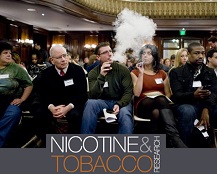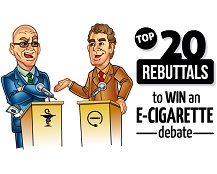The Merry E-Cigarette Vaping Christmas Game, by Brian Fojtik.
A new piece of research has investigated the concentrations of nicotine, carbon monoxide and various volatile organic compounds after e-cigarette use, and compared them to those from a traditional cigarette.
Thoughts on electronic cigarette regulation from vapers, advocates, researchers and bloggers. The vaping community speaks! How should the FDA regulate e-cigs?
This past Wednesday the most populous city in the United States held a public hearing to discuss a proposed amendment to the New York Clean Indoor Air Act. The bill, sponsored by NYC Councilman James F. Gennaro, seeks to regulate usage of electronic cigarettes the same way smoking is prohibited in public places like restaurants, bars, workplaces and parks.
Prof. Riccardo Polosa and Dr. Pasquale Caponnetto have had a letter published in the Lancet Oncology this month, after having spotted the sort of editorial you’d expect to see in a misguided tabloid rather than a prestigious journal.
Spare a thought for the anti-vaping zealots, those who are opposed to e-cigarettes or tobacco in any form, who continually have to rely on similarly flawed arguments in order to make it look like they're maintaining a defensible position. Reading through anti-e-cig arguments is like taking a whistle-stop tour of logical fallacies, and here is our top 10 of the most common.
A new longitudinal study published in Addictive Behaviors has provided evidence that “dual users” of both e-cigarettes and tobacco cigs generally reduce the number of cigarettes they smoke or quit entirely, as well as offering an insight into the behavior of us now-vaping ex-smokers.
Two researchers presented yesterday what may very well wind up one of the most important resources to date against the argument that electronic cigarettes are a gateway to teen smoking.
A new piece of research from Dr. Konstantinos Farsalinos and his colleagues has investigated the potential cytotoxicity of e-cigarette vapor, and found that (shockingly enough) the vast majority of vaporized liquids are much safer than the smoke from traditional cigarettes.
A recent paper which was published in the Harm Reduction Journal by Professor Polosa, summarizes the existing evidence into e-cigs, and looks at the potential damage caused by the misinformation surrounding the technology.
Vaporizing marijuana is not a new thing. E-cigs, on the other hand, are quite new, and it was only a matter of time before people started adapting them to vape marijuana.
A new study published in Lancet from researchers in New Zealand has pitted e-cigarettes against patches to see which approach is more effective.
Vaping is all about Ohm’s Law. When you move into the realms of APVs, where the atomizer resistance and voltage are both often variable, the weird-looking equations actually pretty much determine how powerful your hit of vapor is.
20 of the most commonly heard anti e-cig arguments rebutted by scientists, researchers, and advocates including Dr. Michael Siegel, Dr. Carl V. Phillips, Dr. Farsalinos, Dr. Ross, Chris Price, James Dunworth, Gregory Conley, Paul Bergen, Kristin Noll-Marsh, and Oliver Kershaw.
Do you think e-cigs pose a risk to bystanders? Studies have shown that the vapor of e-cigarettes is less harmful than the air you inhale on a regular basis.
From their medical definitions alone, it's pretty obvious that smoking and vaporizing are not the same thing. Electronic cigarettes were designed as a safer alternative to traditional tobacco smoking.
While it may be true that e-cigs contain trace amounts of said metals, they are still in compliance with federal safety standards and should therefore cause no alarm to health officials or the general public.
Flavored electronic cigarettes appeal to and are targeted toward adults. Just because we age does not mean we lose interest in the delectables of life. Flavored e-cigs undoubtedly taste better than tar-filled tobacco smoke and are a sincere attempt to keep health conscious smokers from falling off the vapor wagon.
Most of us are now well-versed with the 2009 FDA study that found a small amount (1%) of diethylene glycol, a toxic ingredient in anti-freeze, in 1 out of 18 cartridges from just two brands of electronic cigarettes. Not one study since then has found the chemical in any cartridges or liquids, suggesting that the device in question may have been contaminated.
CDC lies about kids using electronic cigarettes. How can e-cigs be gateways to smoking the real thing?




















